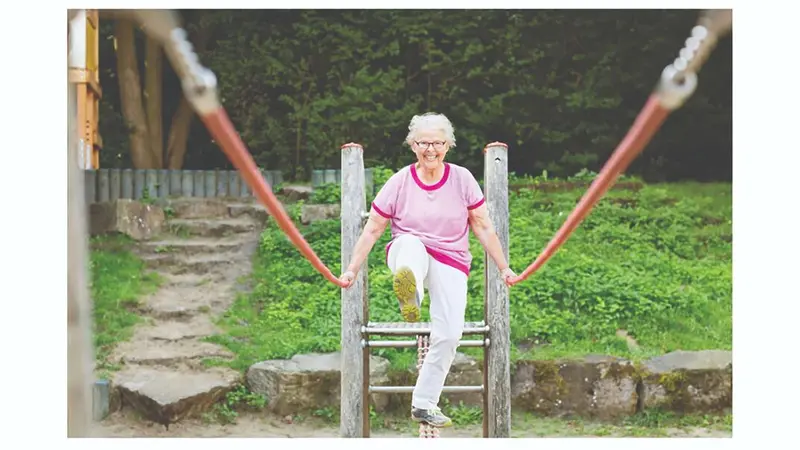
Fit Body
Fit Body
Preventing Falls in Advanced Age: Essential Tips for a Life in Balance
According to the U.S. Centers for Disease Control and Prevention, one out of every four adults aged 65 and older report trips and falls each year, and 9 million of those falls result in an injury. These sobering statistics highlight the importance of learning how to prevent such mishaps.
Here are five easy-to-follow tips.
- Create a Safe Living Environment: Decluttering walkways, securing loose rugs and keeping spaces clear can reduce the chances of tripping and falling.
- Light Spaces: Low-light conditions can be a major culprit in falls. Install bright lights and nightlights in essential areas like staircases and corridors to prevent missteps.
- Equip the Home With Assistive Tools: For added safety, especially in potentially slippery places like bathrooms, install handrails, grab bars and non-slip mats.
- Make Smart Footwear Choices: Opt for shoes that fit snugly, offer good grip and are comfortable. It is best to avoid high heels or any footwear with slippery soles.
- Commit to Regular Exercise: Focusing on exercises that enhances strength, balance and flexibility can significantly lower the risk of falls. Whether it's yoga, walking or tailored balance exercises, staying active is key.
Importance of Exercise in Preventing Falls
Physical activity isn't just about staying fit or losing weight. “Exercise plays a big role in fall prevention,” says Debra Atkinson, certified strength and conditioning specialist and host of the Flipping 50 podcast. “Exercise goes far beyond strength, though. In fact, studies have shown just getting stronger doesn’t always lend itself to better balance.”
For older adults, a combination of regular exercise and balance training can play a pivotal role in preventing falls. Here's why:
- Strengthening Muscle Tone: Regular exercise helps to build and maintain muscle tone, which is crucial for everyday movements. Stronger muscles support the joints, making it easier to get up from a chair, climb stairs or recover quickly when starting to fall.
- Improving Balance: Balance exercises, such as tai chi and certain yoga poses, train the body to control and distribute weight in a centered manner. With better balance, the chances of stumbling or tipping are substantially reduced.
- Enhancing Flexibility: Flexibility exercises can improve the range of motion in joints, resulting in smoother, more fluid movements, which can help prevent missteps and sudden falls.
- Building Bone Density: Weight-bearing exercises like walking or resistance training can strengthen bones, reducing the risk of fractures in the event of a fall.
- Boosting Confidence: Regular exercise can instill a sense of physical confidence. When individuals feel physically strong and agile, they're less likely to be overly cautious or afraid of falling. This can lead to a more active lifestyle, further reinforcing physical strength and balance.
Exercising Tips
Exercise for fall prevention focuses on consistency and the right activities, not just intensity. Here’s a concise guide:
- Start Gradually: Begin with gentle activities like walking and stretching. As stamina is gained, increase the intensity.
- Strength Training: Use resistance bands or body weight. Emphasize leg and core exercises, such as squats and leg lifts, to enhance stability. “Increase intensity by closing your eyes, then moving your head left to right during single-leg lift variations,” recommends personal trainer Scott Elliott, of Del Mar, California.
- Balance Exercises: Enhance balance with activities like standing on one foot, walking heel-to-toe or standing up without hand support. Atkinson recommends disruption practice during balance exercises. “Have someone gently come up and push a bit on your shoulder, hip or leg. You will have to react and respond just as you would if you were righting a fall. Do it on both sides.”
- Flexibility Workouts: Opt for yoga or tai chi, both of which boost flexibility and coordination.
- Join Group Classes: Consider activities that offer physical and social benefits, such as Pilates. Elliot encourages older adults to try dancing or boxing. “The art of coordinating left foot, right foot not only moves your joints but also exercises the brain. Mind-to-muscle is a necessary component to building strength, awareness and balance.”
- Safety First: Exercise in a hazard-free space. If unfamiliar with equipment or exercises, seek guidance.
- Set Goals: Stay motivated with achievable targets, whether walking longer distances or mastering new exercises.
David J. Sautter is a certified trainer, fitness-nutrition specialist, and health and fitness writer.
Original article published at Natural Awakenings


 By
By



